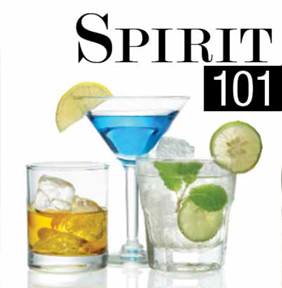Spirit 101
When we say Spirits we are not talking about Aunt Bessie's ghost. We are talking about the hard stuff...liquor. No matter how you enjoy your favorite spirit, straight up, on the rocks or in a cocktail, we have it all to make your bartending experience a success.
Types of Spirits
WHISKEYS
BOURBON
At least 51% of the grains used to make straight bourbon must be corn, while the rest may be a mixture of other grains (usually barley, rye, or wheat). Usually between 80 and 125 proof; the legal minimum strength is 60 proof. Only limestone filtered spring water may be used to lower the alcohol content.
TENNESSEE WHISKEY
Similar in style to bourbon, Tennessee whiskey must be produced in the state of Tennessee and is always filtered through sugar-maple charcoal before going into casks for aging. It is aged for a minimum of two years. Tennessee whiskey was recognized as a separate style by U.S. government officials in 1941.
BLENDED WHISKEY
Blended American whiskey may contain as little as 20% straight whiskey, such as rye or bourbon whiskey; the remaining 80% may be unaged grain neutral spirits or a high-proof light whiskey. Because of this, American blended whiskey is much lighter than Tennessee or bourbon whiskies.
CANADIAN WHISKEY
Mashed, distilled and aged at least three years in Canada in a wooden barrel of not greater than 700 L capacity. Blended, multi-grain liquors typically containing a large percentage of rye, often generically referred to as “rye whiskey.”
IRISH WHISKEY
Standard Irish whiskey is a blend of malt and grain whiskies; pure malt will be labeled such. Usually distilled through both column and pot stills, although there are a few solely pot-distilled brands. The oldest distillery, Bushmills, dates to a 1608 license granted by King James I.
SCOTCH WHISKEY
Scotch must be distilled and matured in Scotland. When an age is listed, it is of the youngest whisky in the blend. Single malt is from one specific distillery. It tends to possess intense flavors and aromas. Blended whisky may contain a combination of whiskies from several malt and grain distilleries.
WHITE SPIRITS
GIN
Gin is typically clean in flavor, but with fruity and herby overtones. It is a dry, white spirit distilled from various grains, and flavored with juniper berries, herbs and spices. It is the juniper that gives gin its distinctive flavor. Imported gins tend to keep more grain character than American gins.
VERMOUTH
Fortified wine flavored with herbs and spices. Dry vermouth can be enjoyed on its own as an aperitif, or in drinks such as martinis. Sometimes used in cooking to add flavor. Sweet vermouth is most often found in a Manhattan cocktail.
RUM
Slightly sweet, fermented and distilled liquor made from sugar cane. Almost all rum today is aged in oak barrels and the longer it remains in the barrel, the darker the color will be. In general, rum is aged for at least a year, however standards for ABV/proof and aging vary from one rum-producing country to another.
TEQUILA
Tequila is distilled from the blue agave plant in Mexico. Usually un-aged – and even when it is, it’s nothing like the aging other spirits are renowned for. Reposado, for example, is aged at least two months, but less than a year. Anejo? One to three years. Mixers [for tequila gondola]. Margarita? Tequila Sunrise? Shooter? Whether you’re mixing it up, or keeping it simple, here’s what you need.
VODKA
Vodka is produced from grain (mostly rye and wheat), potatoes, molasses and other plants. Russian and Swedish vodkas are usually made from wheat, whereas Polish vodkas are usually made from rye or potatoes. All vodka comes out of the still as a clear, odorless spirit. It is sometimes flavored and/or colored with a variety of fruits, herb and spices.
MISCELLANEOUS SPIRITS
BRANDY
Basically, fruit (usually grapes, but also apples, pears, cherries and other fruits) fermented into wine (or cider, as in the case of calvados) and then distilled. Some of the best-known brandies are Cognac, Armagnac, kir or kirshwasser (from cherries), and grappa (Italian pomace brandy).
COGNAC
One of the best-known brandies is cognac. Hailing from the Cognac region of France, it is said to have been discovered in the 16th century. During the aging process, cognac loses approximately 3-4% of its volume through evaporation – a portion known as “the angels’ share.” Romantic in history, rich in flavor, cognac is an elegant after-dinner drink.
CORDIALS & LIQUEURS
Sweet, flavor-infused spirits. Produced by combining a distilled spirit with a strong flavoring agent. Not usually aged for any length of time (although the spirit used to make the liqueur may be). Proprietary liqueurs are unique, often using an old, secret recipe, such as Jägermeister or Frangelico.



